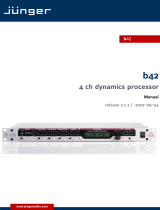Page is loading ...

2ch digital audio leveller
d06
LEVEL MAGIC™


O
p
eration manual do6, cha
p
ter 1
–
Content
–
p
a
g
e 1 of 4
FOREWORD
Thank you for buying and using the 2-channel Digital Audio Level Processor
d06.
You have acquired the latest generation of digital dynamic range processing
and also a piece of equipment which is unique in its design and
specification.
Please read this manual carefully to ensure you have all the information you
need to use the 2 - channel Digital Audio Level Processor d06.
The unit was manufactured to the highest industrial standards and went
through extensive quality control checks before it was supplied.
If you have any comments or questions about installing, setting-up or using
the d06, please do not hesitate to contact us.
1

O
p
eration manual do6, cha
p
ter 1
–
Content
–
p
a
g
e 2 of 4
CONTENT
2. Function description
2.1 Basic description
2.2 Block diagram
2.3 Audio signal processing
2.3.1 Gain
2.3.2 Audio Leveler Level Magic™
2.3.3 Limiter
2.4 The Jünger Audio Dynamics Principle
2.4.1 Program
2.4.2 Influence of signal delay time
3. Installation
3.1 Unpack the unit
3.2 Power supply
3.3 Connections
3.4 Rack mounting
3.5 Operation safety
3.6 Synchronization the digital output
3.7 Rear panel connectors
3.7.1 Audio connections
3.7.2 GPI
3.7.3 GPO (tally)
3.7.4 Serial RS422 or RS232 or CAN
3.7.5 LAN ( Ethernet)
3.8 Switches and jumpers for configuration
3.8.1 Selection of the serial remote interface
3.8.2 Calibration of the analog inputs and outputs

O
p
eration manual do6, cha
p
ter 1
–
Content
–
p
a
g
e 3 of 4
4. Network integration
5. Operation
5.1 GUI operation
5.1.1 Setting the d06 parameters
5.1.2 Setup the device
5.1.3 General settings
5.1.4 Preset operation
5.1.5 GPI/O set up
5.1.6 LAN Controller set up
5.1.6.1 System Configuration
5.1.6.2 Backup 6 restore
5.1.6.3 Software update
5.1.6.4 Reboot the LAN Controller
5.2. Front Panel Operation (optional)
5.2.1 Setting the reference levels
5.2.2. Menu selection
5.2.3. Preset menu
5.2.4. Configuration menu
5.3.5. Parameter menu
6. Technical specifications
7. Warranty and service information
8. CE Declaration of Conformity

O
p
eration manual do6, cha
p
ter 1
–
Content
–
p
a
g
e 4 of 4

2. FUNCTIONAL DESCRIPION
operation manual d06, chapter 2 - Functional Description - page 1 of 8
FUNCTIONAL DESCRIPTION
The digital dynamics processor d06 is a professional studio device that is
performing automated levelling of digital audio signals.
The dynamic range processor principles developed by Jünger Audio enable
level managing devices like compressors, AGC and limiters to be produced
with exceptionally high audio quality, without coloration, pumping, breathing,
distortion or modulation effects sometimes associated with this type of
processor.
In short, almost inaudible processing - with ease of use. The outstanding
quality of the processing is based on the Multi-Loop dynamic range control
principle in combination with adaptive controlled processing algorithms
developed by Jünger Audio.
The unit is easy to operate and requires only a limited number of settings to
be made by the user to achieve optimum results. All other parameters
necessary for inaudible processing are continuously automatically controlled
in response to changes in the programme signal.
features
• 2-channel digital audio levelling processor
• various link modes: stereo 1/2 or ch1 and ch2 independent
• adjustable input gain (channel independent) -20...+20 dB
• adaptive controlled audio levelling processing
- Leveler, Transient Processor, Limiter
• user friendly preset and recall function (10 presets)
• extern sync mode, AES/EBU, WCLK or VIDEO
• RS-232/422 interface for serial remote
• GPI interface for parallel remote control, tally output
• operation via web interface (LAN)
• optional operation via front panel
2.1
BASIC
DESCRIPTION
2

2. FUNCTIONAL DESCRIPTION
operation manual d06, chapter 2 - Functional Description - page 2 of 8
2.2
BLOCK
DIAGRAM

2. FUNCTIONAL DESCRIPION
operation manual d06, chapter 2 - Functional Description - page 3 of 8
All signal processing is done in the digital domain by Texas Instruments
floating point signal processors. The use of 32 bit word length for calculation
ensures that there is no deterioration in signal quality, even if an audio signal
with a maximum word length of 24 bit is input into the processing of the unit.
GAIN means linear amplification of input signals. The input gain can be
changed in steps of 0.1 dB , within a range from -20...+20 dB for both
channels.
Level Magic ™ is a unique algorithm to make automated audio levelling
possible.
2.3
AUDIO SIGNAL
PROCESSING
2.3.1
GAIN
2.3.2
AUDIO LEVELLER
LEVEL MAGIC™
AGC
Input level change
Pic. 2 is showing a
theoretical level change of
+5dB and –5dB around
program level.
Working with AGC
In pic.3 a conventional
AGC is used to adjust the
level. As we can see the
AGC needs a certain time
to react, that is necessary
for mostly inaudible gain
correction. But that’s too
long to get a proper
correction of the input level
change.
Level Magic ™
Level Magic ™ is a unique
combination of a transient
processor and an adaptive
AGC process. The
transient processor can fill
the lack of level control
against the slow acting
AGC. The total gain of
Level Magic ™ is the
addition of the gain by the
transient processor and the
gain of the AGC.
adaptive
AGC
Transient
Processor

2. FUNCTIONAL DESCRIPTION
operation manual d06, chapter 2 - Functional Description - page 4 of 8
The Level Magic ™ process needs to be setup in three steps
- select one of the default presets for your apllication
(see preset description in chapter 5)
- adjust the operation level and peak level referring to standards that
are used for your application
- if the default preset is not giving satisfying results change the
parameters indivdually
Level Magic ™ is using a unique combination of QP and RMS level detectors
to analyze the incoming audio signal. By comparing QP and RMS
measurement results we can find out how much transients are coming in.
Dependent on that the necessary resulting gain is controlled in relation
between transient processor and AGC.
Transient processor is doing fast gain change and the AGC is doing slow gain
change (depending on settings). The way how Level Magic is acting on the
audio is mostly determined by balancing between slow and fast gain changing
process. The AGC should be set in a way that the gain change is mostly
inaudible (1dB per 5 seconds or slower). The Transient Processor should be
set that incoming level jumps are reduced but originally dynamic range is not
changed too much. As more possible gain by the Transient processor
(RANGE), as more reduction of the dynamic range will be.
SOFT level control: AGC range …15dB, time >=2min
Transient range …4dB, soft process
MID level control: AGC range …12dB, time >=1min
Transient range …6-8dB, mid process
HARD level control: AGC range …10dB, time >=40sec
Transient range …10dB, hard process
Parameter description:
AGC
OP-level operation level, target level for the AGC and for
the Transient Processor
Range max. gain by the AGC
Time time to reach the max. gain change
Gate threshold level where the AGC stops gain
change and moves gain slowly to the long
term average gain
Transient Processor
Process a combination of level ratio and release
characteristic for the fast gain change (soft, mid,
hard)
Range max. level change by the Transient Processor
Adjustment
procedure
Process
description
Parameter
description
Transient
Processor
AGC
Level
Detection
Limiter

2. FUNCTIONAL DESCRIPION
operation manual d06, chapter 2 - Functional Description - page 5 of 8
The static characteristics of the d06 limiter usually refers to a digital output
level of 0 dBFS (dB Full Scale). This is useful for most applications of the
dynamics processor as the on-following digital recording system is supposed
to be balanced down to the final bit.
For applications using headroom the output level can be adjusted within 0 ... -
20 dBFS in steps of 0.1 dB. The limiter threshold determines the maximum
output level.
The static characteristic for the limiter at a limiter threshold of -12dBFS is
illustrated in fig. 6.
-50
-40
-30
-20
-10
[dBFS]
-10
-20
-30
-40
-50
-60
output
input
limiter
threshold
0...-20dBFS
max. output
level
For the dynamics functions a signal delay of approx. 2 ms is built in. This
delay makes it possible to arrange the algorithm of the limiter in such a way
that the control mechanism is activated before maximum level is reached (look
ahead limiter). Within the rise time of the signal the peak level is recognised
and the maximum is calculated in such a way that limiter threshold level is
reached precisely without causing clipping.
A change in the dynamic range of an audio signal is a non-linear process. The
gain of a dynamic range processor is not constant as it is with the gain of a
linear amplifier. The gain varies in time depending on the input signal and
depending on the specific control algorithm of the dynamics processor. These
variations in the gain, which represent the real control process, should take
place without any bothersome side effects.
The dynamic range processor principle developed by Jünger Audio makes it
possible to realize dynamics processors (compressor, limiter, expander) with
very high audio quality, without signal discoloration, pumping or breathing,
without distortion and modulation products - in short, with almost inaudible
processing - and they are very easy to use.
2.3.3
LIMITER
fig. 6:
basic function:
limiter
2.4
THE JUNGER
AUDIO DYNAMICS
PROCESSOR
PRINCIPLE

2. FUNCTIONAL DESCRIPTION
operation manual d06, chapter 2 - Functional Description - page 6 of 8
The Junger Audio dynamics processors work according to a Multi-loop
principle, operating with an interaction between several frequency linear
control circuits. This is quite different to the popular multiband structure which
changes the sound.
The resulting attack and release times of the Multi-loop system are variable
and adapted to the evolution of the input signal. This allows relatively long
attack times during steady-state signal conditions but also very short attack
times when there are impulsive input transients.
The Multi-loop structure also permits a short time delay between the control
circuit and the gain changing element. The gain control circuit has time to
preview the signal and become active before it reaches the output. This is
particularly important for the limiter, which provides a precisely leveled output
signal absolutely free of overshoots (clipping).
For some of the control parameter it is possible to define a limited range of
time constant values which are allowed for the adaptive dynamic range
algorithms. Inside this range the time constants can be varied by the adaptive
processing. Setting the range of time constant values may be sometimes
useful, to get the best signal processing performance regarding specific
programme material.
Parameter related to the transient response of the control circuit are important
for distortionfree processing. These time constants are allways adaptive
controlled without remarkable limitation of parameter range. This is caused by
the presence of transient pulses in allmost each kind of programme material.
The algorithm has to guarantee best reaction for fast increasing level of
transient signals anytime even if classical music with slow dying out
characteristic is processed. In all cases the attack time of the limiter for very
short transients is zero.
2.4.1
PROGRAM
A A
f
delay
1
1
2
2
n m
f
Multi - Band Multi - Loop

2. FUNCTIONAL DESCRIPION
operation manual d06, chapter 2 - Functional Description - page 7 of 8
Especially the release time of the control circuit has more influence to the
increase of loudness as any other parameter. The ranging of time constants in
processing time groups reflects this fact. The range for processing time shows
influence on release time parameter mostly.
The selection of the parameter limiter PROCESS changes the range of time
constant values as follows:
PRO processing time
---------------------------------------------------------
0 2 ms to 0.2 sec
1 5 ms to 0.5 sec
2 10 ms to 0.8 sec
3 15 ms to 1.2 sec
4 30 ms to 2.5 sec
5 50 ms to 3.5 sec
6 70 ms to 5.0 sec
7 100 ms to 6.0 sec
8 150 ms to 8.0 sec
9 250 ms to 10.0 sec
The audio signal delay through the dynamics processor is approx. 2ms due
to delaying of the audio signal using internal memory. A small delay is
deliberately introduced to the audio signal in order to allow limiter and
compressor algorithms which can 'preview' the audio signal before
changing it. That is the signal curve can be changed before maximum level is
reached. This delay must be considered before attempting to mix signals
processed by the dynamics processor with other undelayed signals.
When mixing together a delayed signal and a direct signal there may be
cancellation of the signal waveform at some frequencies and re-inforcement
of the waveform at other frequencies (comb filter effect). Corresponding
2ms delay of direct signals should therefore be carried out before mixing
them with delayed processed signals.
2.4.2
INFLUENCE OF
SIGNAL DELAY
TIME

2. FUNCTIONAL DESCRIPTION
operation manual d06, chapter 2 - Functional Description - page 8 of 8

3. INSTALLATION
operation manual d06, chapter 3 - Installation - page 1 of 10
INSTALLATION
The digital audio level processor d06 was packed carefully in the factory and
the packaging is designed to protect the equipment from rough handling.
Please examine carefully the packaging and its contents for any signs of
physical damage, which may have occured in transit.
The digital audio level processor d06 is a device under the safety category
Schutzklasse 1 in keeping with the VDE 0804 standards and may only used
with power supply installations built according to regulations.
Check the voltage details printed at the rear panel are the same as your local
mains electricity supply.
The digital audio level processor d06 is equipped with standard connectors
(see also chapter 3).
Before connecting the digital audio level processor d06 switch the power off at
all connected units.
The digital audio level processor d06 is made as standard 19“ unit (EIA
format). It occupies 1 RU (44 mm height) space in a rack. Please allow at
least additional 3inch of space for the connectors on the rear panel.
When installing the unit in a 19“ rack the rear side of the unit needs some
support, especially for mounting in flight cases.
The digital audio level processor d06 should not be installed near units which
produce strong magnetic fields or extreme heat. Do not install the audio
processor directly above or below power amplifiers.
If, during operation, the sound is interrupted or displays no longer illuminate,
or if abnormal odor or smoke is detected immediately disconnect the power
cord plug and contact your dealer or Junger Audio.
3.1
UNPACK THE
UNIT
3.2
POWER SUPPLY
3.3
CONNECTIONS
3.4
RACK MOUNTING
3.5
OPERATION
SAFETY
3

3. INSTALLATION
operation manual d06, chapter 3 - Installation - page 2 of 10
The digital audio level processor d06 has a digital signal output. For the
problem-free combination of following digital devices, the digital signal
processing can be locked to an external clock reference. The selection of the
corresponding sync source is made in the SYNC MODE menu during setup. If
the chosen sync input is connected with the sync signal, this signal is used for
synchronization automatically. All sync sources can be used for locking A/D-
converters at the analogue inputs as well. The digital output signal can be
clocked with the following clock frequencies:
INTERNAL locks both the A/D-converters and the digital output with
the internal reference 44,1 or 48 kHz. Digital inputs are
connected via sample rate converter
AES INPUT locks with the clock frequency of the input signal at
digital input CH 1/2 (AES/EBU, 44,1...48 kHz)
EXT AES locks with the AES signal at the sync input
(AES, 44,1...48 kHz) Digital inputs are connected via sample
rate converter
EXT WCLK locks with the word clock signal at the sync input
(WCLK, 44,1...48 kHz) Digital inputs are connected via sample
rate converter
EXT VIDEO locks with black burst at sync input (internal 48 kHz) Digital
inputs are connected via sample rate converter
Important Note! Video Sync is an option for the d06. For the very rare case
that you can not synchronize the d06 to AES, you may buy such option from
Junger Audio. Pls contact your local dealer for details.
POWER INPUT
IEC mains input connector 85-264V, 50/60 Hz with integrated fuse
REMOTE
serial remote interface RS-422 (232)
connector: 9pin SUB-D, female
GPI
parallel remote interface
TALLY-out open relay contact
connector: 25pin SUB-D, female
GPI-in optical coupler +3,5…+30V
connector: 15pin SUB-D, female
3.6
SYNCHRONIZING
THE DIGITAL
OUTPUT
3.7
REAR PANEL
CONNECTORS
DIGITAL
I/O ANALOGUE
I/O
SYNC IN
WCLK OUT
LAN-controller
web interface
SERIAL
REMOTE
GPI REMOTE
IN/OUT

3. INSTALLATION
operation manual d06, chapter 3 - Installation - page 3 of 10
SYNC
SYNC IN input for ext. sync signals :
AES 3 format, 75 Ohm, unbalanced
video sync (black burst), 75Ohm, unbalanced
word clock (TTL level), 75Ohm, unbalanced
Connector : BNC socket
WCLK OUT output for word clock (system clock of d06)
(TTL level), 75Ohm
Connector : BNC socket
DIGITAL IN
AES/EBU standard format
Connector : XLR female
DIGITAL OUT
AES/EBU standard format
Connector : XLR male
ANALOG IN/OUT
Analog input 24bit A/D-converter
floating, balanced
Connector : XLR female
Analog output : 24 bit D/A-converter
Floating, balanced
Connector : XLR male
The analogue audio inputs are RFI filtered. Analog I/Os are balanced and
floating like transformer coupled devices. All the audio connectors are via rear
panel mounted connectors. Standard XLR connectors are used. These are
always wired to the AES standard:
pin 1 X Shield
pin 2 L Live audio 0°
pin 3 R Return audio 180°.
Balanced connections are preferred whenever the other equipment provides
balanced inputs/outputs. All line level connections should be wired with twin
shielded cable for low noise and reliability. The shields of the cable should be
connected at one end only. Input cable shielding therefore needs to be
derived from the signal source end as pin 1 is ground lifted for low frequencies
at the inputs.
If the equipment that drives the digital audio level processor d06 has
unbalanced outputs you must add a wire jumper to connect Pin 1 of the XLR
to Pin 3.
If the equipment connected to the d06 has unbalanced inputs only, we
recommend to use a balanced (i.e. 2 core shielded) cable where Pin 1 and
Pin 3 are connected in the XLR plug end away from the digital audio level
processor d06.
3.7.1
AUDIO
CONNECTIONS

3. INSTALLATION
operation manual d06, chapter 3 - Installation - page 4 of 10
The digital audio level processor d06 can be remote-controlled by means of
parallel GPI inputs.
Use to : * recall of PRESETs 1-4
* switch between STEREO / 2CH link mode
* selection of INPUT 2 / 1
* switching the device to BYPASS
Connector : D-SUB 15pin, female
Pin assignment of the connector :
Pin Signal name Functions
1 GPI1 in Defined by d06 config
2 GPI2 in Defined by d06 config
3 GPI3 in Defined by d06 config
4 GPI4 in Defined by d06 config
5 GPI5 in Defined by d06 config
6 GPI6 in Defined by d06 config
7 GPI7 in Defined by d06 config
8 GPI8 in Defined by d06 config
9 + 5V 110 Ω
10 GPI1/GPI2 common
11 GPI3 common
12 GPI4 common
13 GPI5 common
14 GPI6 common
15 GPI7/GPI8 common
Shield -5V GND of d06 Chassis
Electrical specification :
GPI input potential free by opto-coupler in line with
a current source
ON: +3.5…+30V between GPIx input
and GPx common
OFF: less then 1.5V between GPIx input
and GPIx common
For serial numbers S/N 59 and higher (HW Revision 2a and higher) the
polarity of the GPI inputs has been changed. to make use of the internal
ground based auxiliary 5 V for "low active" switching.
ON: -3.5…-30V between GPIx input
and GPx common
OFF : less then 1.5V betwee GPIx input
and GPIx common
Signal duration must be at least 50msec.
Note : An internal auxiliary voltage feed of +5V is available on pin 9
via a 110 Ω resistor. Ground is available from the shield of the connector
only! When using the auxiliary voltage feed, there is no electrical isolation
given anymore and the risk to inject unwanted noise is high!
Important Note : You must take care about the polarity of the external voltage
applied to the GPIs. Wrong polarity may destroy electronic components
and may cause fire inside the d06!
3.7.2
GPI

3. INSTALLATION
operation manual d06, chapter 3 - Installation - page 5 of 10
The digital audio level processor d06 can aknowledge specific device statuses
via parallel GPO (Tally) lines.
Use to : monitor the d06 status
Connector : D-SUB 25pin
female panel jack
Pin assignment of the connector :
Pin Signal name Functions
1 Tally 1 normally closed
2 Tally 1 normally opened Defined by d06 config
3 TALLY 2 common
4 Tally 3 normally closed
5 Tally 3 normally opened Defined by d06 config
6 TALLY 4 common
7 Tally 5 normally closed
8 Tally 5 normally opened Defined by d06 config
9 Tally 6 common
10 Tally 7 normally closed
11 Tally 7 normally opened Defined by d06 config
12 TALLY 8 common
13 + 5V 110 Ohm
14 TALLY 1 common
15 Tally 2 normally closed
16 Tally 2 normally opened Defined by d06 config
17 TALLY 3 common
18 Tally 4 normally closed
19 Tally 4 normally opened Defined by d06 config
20 TALLY 5 common
21 Tally 6 normally closed
22 Tally 6 normally opened Defined by d06 config
23 TALLY 7 common
24 Tally 8 normally closed
25 Tally 8 normally opened Defined by d06 config
Screen -5V GND of do6 chassis
Electrical specifications :
Tally output relay : common / normally closed / normally opened
24V - 1A
125V - 0,5A
P
max = 62,5VA
3.7.3
GPO (TALLY)

3. INSTALLATION
operation manual d06, chapter 3 - Installation - page 6 of 10
The digital audio level processor d06 can be remote-controlled by means of
serial remote RS-232/422.
Use : * network configuration
* administrative setup (consol interface)
Protocol : available on request
Connector : D-SUB 9pin
female panel jack
Pin assignment of the connector in serial interface mode :
Pin Signal name Functions
1 Rx + RS422
2 TxD RS232
3 RxD RS232
4 NC not used
5 GND Ground
6 Rx - RS422
7 NC not used
8 Tx - RS422
9 Tx + RS422
Pin assignment in CAN-bus mode :
Pin Signal name Functions
1 NC Not used
2 CAN-l CAN-bus low signal
3 NC Not used
4 NC Not used
5 GND Ground
6 GND Ground
7 CAN-H CAN-bus high signal
8 NC Not used
9 NC Not used
This connector has multiple functions which may be internally changed by
connectors and jumpers (see 3.8). The factory default format setting is RS232
and it is connected with the serial interface of the LAN Controller.
By using a terminal program (115kB/sec. 8,N,1 no flow control) you may
communicate with the consol of the LAN Controller, e.g. to change the IP
configuration of the device.
3.7.4 Serial
RS422
or
RS 232
or
CAN
/









